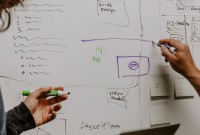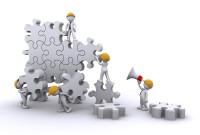- Home
- Business Processes
- Industry Knowledge
- Aerospace Industry
- Automotive Industry
- Banking Domain
- BFSI Industry
- Consumer/ FMCG Industry
- Chemicals Industry
- Engineering & Construction
- Energy Industry
- Education Domain
- Finance Domain
- Hospitality Domain
- Healthcare Industry
- Insurance Domain
- Retail Industry
- Travel and Tourism Domain
- Telecom Industry
- Leadership Skills
- eLearning
- Home
- Leadership Skills
- Leadership Theories
- Cognitive Resource Theory
Cognitive Resource Theory
The cognitive resource theory states the influence of the leader's resources on his or her reaction to stress. The cognitive resources of a leader are experience, intelligence, competence, and task-relevant knowledge. Stress is common in resource managing situations, and this cognitive theory emphasizes how intelligence and experience are each best under different stress situations. This theory is the reconceptualization of the Fiedler model.
In the early 1990s, the original model of Fiedler was re-conceptualized by Fiedler and his associate Joe Garcia, as Cognitive Resource Theory. In this model, the focus has been laid on the role of stress as a form of situational un-favorableness and how a leader’s intelligence and experience influence her/his reaction to stress.
What is meant by cognition?
Cognition is the mental action or process of acquiring knowledge and understanding through thought, experience, and the senses. Good examples of cognition are learning and our ability to reason through logic. Cognitive processes use existing knowledge and generate new knowledge. Cognitive processes are analyzed from different perspectives within different contexts like psychiatry, psychology, education, philosophy, and computer science.
Cognitive Resource Theory of Leadership
The Contingency Model developed by Fiedler was criticized for its lack of flexibility and also over the accuracy of the LPC scale. Fiedler then went on to develop the Cognitive Resource Theory (CRT) which takes into account the personality of the leader, degree of situational stress, and group-leader relations.
The assumption behind this theory is that stress impacts the ability to make decisions. It is the enemy of rationality and a leader cannot think in a logical and analytical manner if she/he is under a high level of stress. According to this proposition, the importance of a leader’s intelligence and experience to effectiveness differs under low and high-stress situations.
Fiedler and Gracia state that a leader’s intellectual ability correlates positively with performance under low stress but negatively under high stress. And conversely, a leader’s experience correlates negatively with performance under low stress but positively under high stress.
Thus, according to Fiedler and Gracia, the level of stress in a situation, determines whether an individual’s intelligence or experience will contribute to leadership performance.
Predictions of Cognitive Resource Theory
The Cognitive Resource theory predicts that the leader's abilities and intelligence can aid organizational success only when leaders adopt a directive leadership style, the situation is stress-free, the group members are supportive and the task requires high intellect. These attributes are discussed below:
1. Directive Approach
When a leader is better in cognitive abilities like intelligence, planning, and decision-making, he must follow a directive approach to improve the overall performance of the team. He needs to communicate to the group what to do, to ensure his plans and decisions are implemented, hence improving the overall performance of the group.
When the group and the people on the group are better than the leader in cognitive abilities, then the leader should choose a non-directive approach. He should seek ideas from the group and identify the best approach/idea and move ahead with the same.
A leader's cognitive ability contributes to the performance of the team only when the leader uses the directive leadership style.
2. Impact of Stress
Stress has a direct co-relation with intelligence and decision quality.
When there is a low stress, then intelligence is fully functional and makes an optimal contribution.
When there is high stress, natural intelligence does not make any difference, but may also have a negative effect.
3. Supportive Group Members
A leader's abilities will contribute to group performance only when group members are supportive of the leader and his goals. In such a situation leader's directions can be easily followed and implemented.
4. Cognitively Demanding Tasks
The intellectual abilities and intelligence of the leader can only be utilized efficiently in difficult, cognitively demanding tasks.
What are the practical applications of Cognitive Resource Theory?
The theory proposes the style of leadership required depending on three variables – the degree of stress, situational control, and task structure.
Leaders should be trained on stress management so that a leader's intellect can be most effectively utilized and also to train leaders to take a directive approach when their knowledge will benefit the group but a less directive approach when group member abilities will contribute to performance.
Based on this theory, for a given situation, depending on the level of the stress, leaders can decide on whether to rely on intelligence or on experience. For low-stress situations, one should rely on intelligence; however, for high-stress situations, one should rely on experience.
In high-stress situations, leaders who are more experienced will produce more quality results. In high-stress situations, rational solutions are generally not available and hence intelligence will not be able to support the decision-making process, whereas previous experience can allow the leader to react.
What are the cognitive resources of the self?
The cognitive resources of a leader refer to their experience, intelligence, competence, and task-relevant knowledge. A leader's knowledge can contribute to performance if it is efficiently communicated, hence requiring a directive leader and also a compliant group that is willing to undertake the commands of the leader.
Related Links
You May Also Like
-
Generating Ideas using Brainstorming
The brainstorming technique was developed by Alex F. Osborn in 1957 and brainstorming means where a team of members generates a large amount of alternative fruitful ideas on a specific problem without any criticism and then evaluates each idea in terms of their pros and cons. Brainstorming techniques fall into four broad categories: visioning, exploring, modifying, and experimenting.
-
All the teams are dynamic in nature and they take time to come together, they form, develop, and grow in stages, over a period of time. Teams go through five progressive stages: Forming, Storming, Norming, Performing and Adjourning. In this article, we want to introduce you to these stages of team development and certain strategies that you can use to help the team grow and develop in each of these stages.
-
Contingency Theories in Action
Contingency theory suggests matching the best leader to a specific situation based on situational factors and the leadership style. The practical application of theory can be done in various ways. The workplace example is to determine the best candidate for a given set of requirements using the LPC score. Applying the model to determine a leader's ability to adapt in the scenario of a new project etc..
-
Situational Theories of Leadership
The situational theories of leadership assume that the most effective style of leadership depends from situation to situation. Situational leadership is a leadership style in which the leader must adjust to match the development needs of the followers. They must adapt varying behaviors to strike the right balance between task & relationship based on different levels of maturity of followers and also as followers develop and cultivate their skills.
-
Management theories are the recommended management strategies that enable us to better understand and approach management. Many management frameworks and guidelines were developed during the last four decades.
-
The Psychodynamic Approach to leadership focuses on leaders building an understanding of their personality characteristics to know why they act or react in certain ways. Psychodynamics theory aims to explain the dynamics of human behavior in which lies the essence of leadership, by analyzing various motives that govern a person's behavior. This information can be used to develop leaders and followers by understanding their responses based on their personalities.
-
Self-Fulfilling Prophecy (SFP) Leader Theory
Pygmalion theory of Leadership is a model of SFP at work involving supervisory expectancy based on the pygmalion effect. This effect is a type of self-fulfilling prophecy (SFP) in which raising leader's expectations regarding subordinate performance boosts the group's performance. Managers who are led to demand more from their team, lead the team to better performance. There is some evidence that the SFP effect does exists.
-
Process & Stages of Creativity
Creative ideas do not come just like that. There is a process to it. There are a number of techniques of creativity to support the generation of ideas but the widely practiced ones are brainstorming and lateral thinking. Most innovations are not so much the product of sudden insights as they are the result of a conscious process that often goes through multiple stages. The creative process can be divided into four stages of preparation, incubation, evaluation, and implementation.
-
The great man theory of leadership is a 19th-century idea that states a person is either a natural-born leader or not. Some people are born with the necessary leadership attributes that help them create a great impact on society, politics, or the military. The theory focuses on identifying the innate qualities and characteristics possessed by great men.
-
David Kolb produced this popular model for learning in 1984. The model suggests four stages of learning which most learners go through in order to learn effectively. Leaming is itself a process of change. Something is added to our perception and prepared us for the next impression, which will change our understanding yet more, however minutely. The Kolb contribution is a significant one because it practically equates change and learning.
Explore Our Free Training Articles or
Sign Up to Start With Our eLearning Courses

About Us
Learning
© 2023 TechnoFunc, All Rights Reserved










